Mallorca
Top-Rated Tourist Attractions in Majorca (Mallorca)
Mallorca is a gorgeous Mediterranean island with beautiful weather, stunning scenery, and delicious cuisine. The largest of the Balearic Islands, Mallorca is part of Spain but has a more rugged landscape and otherworldly quality. Rocky mountains and lush wooded hillsides fall steeply down to the sea.
Along the picturesque coastline, dramatic cliffs offer sensational viewpoints, and pristine coves sparkle with crystal-clear waters. Vacationers are also delighted by the historic towns and charming villages, loaded with tourist attractions like medieval churches, ancient castles, and art museums. The joy of Mallorca is the combination of culture and nature.
In the same day, tourists can visit the glorious Gothic cathedral of the capital city, then sunbathe on a pristine beach. Stroll through the walled medieval village of Alcúdia, then be inspired by a 15th-century monastery or relax at the glamorous seaside resort of Puerto Portals. With so many options packed into this idyllic island, tourists will have plenty of reasons to stay for a week's vacation or longer.
Discover more things to do and places to visit with our list of the top attractions in Majorca.
1. The Cultured Capital City of Palma de Mallorca
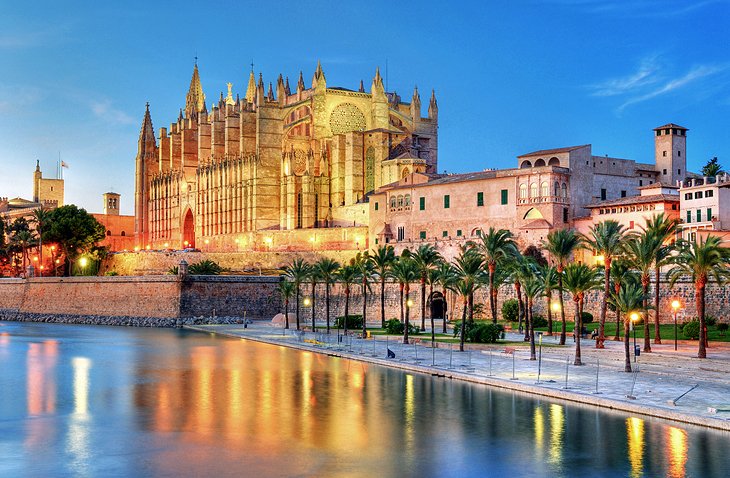
The Cultured Capital City of Palma de Mallorca
A beautiful capital city, Palma de Mallorca offers the perfect combination of seaside relaxation and culture. Two impressive monuments, the cathedral and the castle, give this city the prestige of other capitals in Europe.
The glorious Catedral de Mallorca (La Seo) overlooks the Old Harbor and appears from a distance as a beacon of faith. This monumental sandstone building dates to the 13th century but wasn't completed until the 17th century. The splendid Gothic facade features sculptural decorations by Guillermo Sagrera. Visitors are awed by the interior of the cathedral with its aisled nave rising to a height of 44 meters. The massive space covers an area of 6,600 square meters.
Splendid stained-glass windows including several rose windows (the largest dates from 1370) illuminate the sanctuary with an ethereal glow. Much of the interior was remodeled by famous Catalan architect Antoni Gaudí in the early 20th century. In the Capilla Real (Royal Chapel), Gaudí's gigantic baldachin is shaped like a crown of thorns. The Capilla de la Trinidad contains the sarcophagi of Kings Jaime II and III. From the terrace on the south side of the cathedral, tourists can enjoy a magnificent view of the bay.
The formidable 13th-century Castillo de Bellver sits on a hilltop three kilometers from the historic center of Palma de Mallorca. Once a royal stronghold, the castle's unusual circular plan was influenced by Eastern architecture. A bridge leads into the castle's courtyard, which is lined with Romanesque and Gothic arcades. The castle is open to the public and has a history museum and chapel.
Other attractions include the Fundación Pilar i Joan Miró in the house where the artist lived. This museum has an excellent collection of paintings, drawings, and sculptures by the Catalan artist. For those who prefer to lounge by the sea, the nearest option is near the Miro Foundation at the Cala Major. This wide sandy beach is very popular during summertime. Other beaches include the Playa de Palma and the Playa del Arenal.
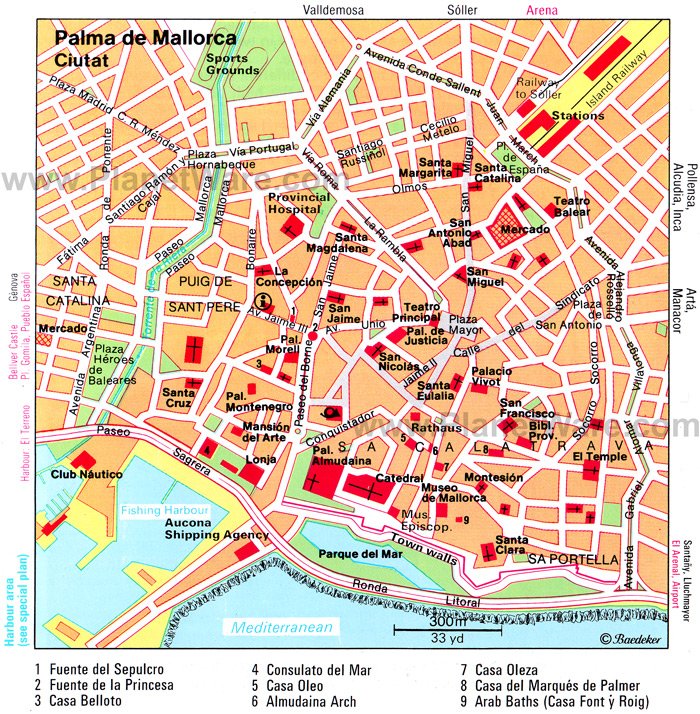
Palma de Mallorca Map - Attractions
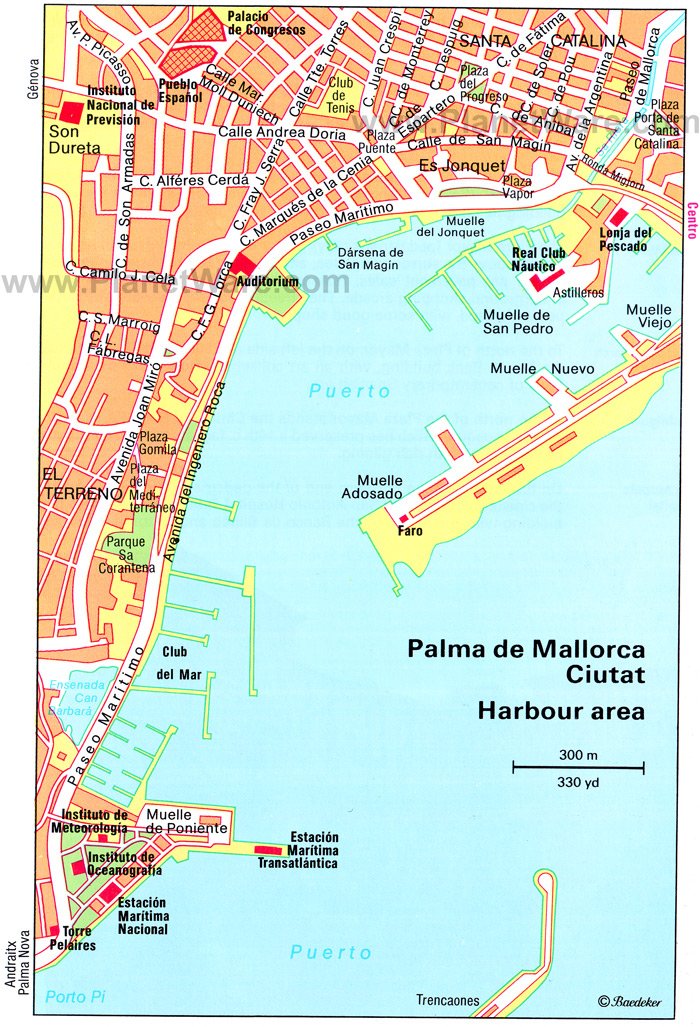
Palma de Mallorca Harbour Area Map
2. Alcudia's Old Town
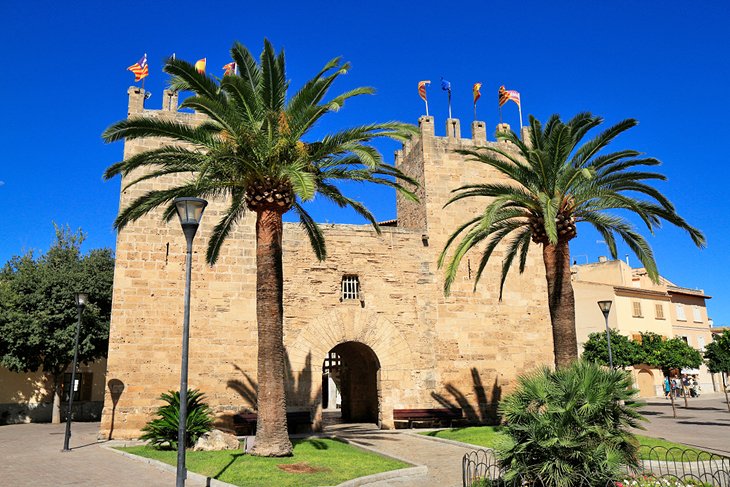
Surrounded by lush greenery and pine forests, Alcúdia is one of the most scenic towns in Mallorca. This wonderfully preserved walled medieval town is also known for its interesting historic monuments, delicious cuisine, and traditional festivals.
The town lies a distance from the sea and was fortified to protect against pirates that were a danger during the Middle Ages. Of the ancient ramparts, only the Xara and Palma gates and the Renaissance-era Bastion of Sant Ferran remain. Alcúdia has a distinct Old World ambience with it winding medieval streets and palatial Renaissance houses.
Important churches include Santa Ana and Sant Jaume and the Baroque chapel of Sant Crist with a 15th-century image of Christ. Alcúdia also has archaeological sites as the town was built on the site of an ancient Roman settlement. Remains of Roman houses, a forum, and an amphitheater lie to the south of Sant Jaume Church.
Several interesting tourist attractions are found outside the town. For those who enjoy bird-watching, La Albufera natural park on the bay attracts more than two hundred species of birds throughout the year. A popular nearby seaside destination is the resort of Puerto Alcudia with its sandy beach, stylish seaside promenade, and restaurant scene.
The coastline around this area also has many pristine coves of crystal-clear water. The Yannick & Ben Jakober Foundation is an excellent modern and contemporary art museum (open to the public on Tuesday, guided tours only by appointment Wednesday through Saturday) This eclectic museum is seven kilometers from Alcudia in a beautiful garden setting with a sculpture park.
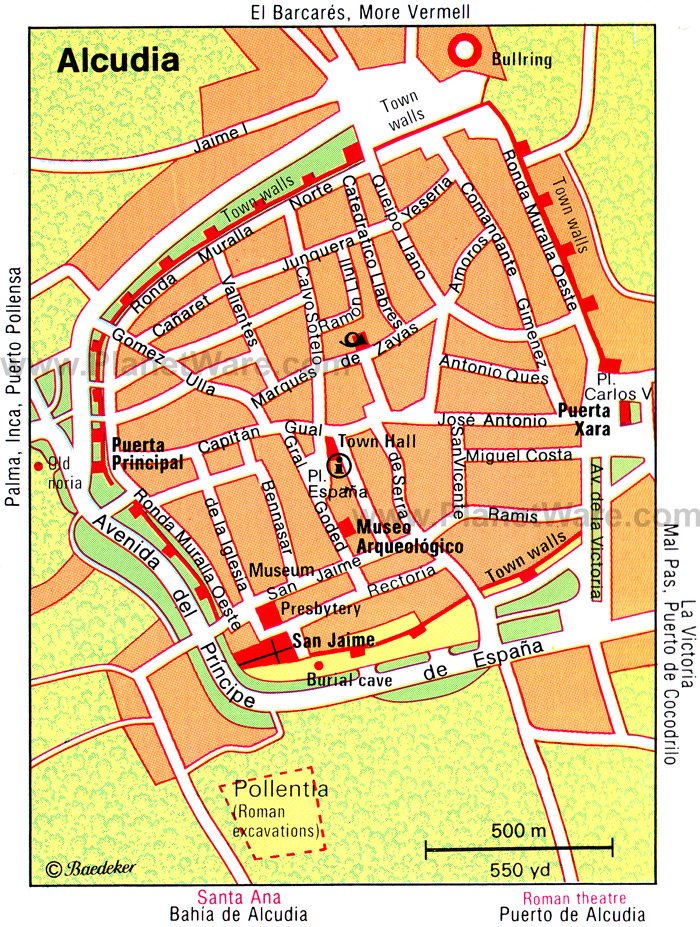
Alcudia Map - Attractions
3. Puerto Portals: A Glamorous Seaside Resort
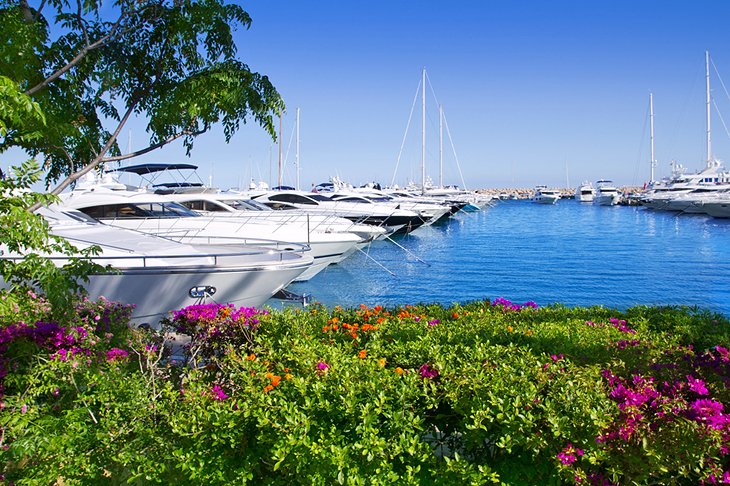
Puerto Portals
This upscale seaside resort on the Southwest Coast of Majorca is a favorite destination of the Spanish royal family and other trendsetting visitors. The chic marina is filled with luxury yachts and draws fashionable people to the yacht club, stylish shops, cafés, and restaurants. With its expensive boutiques and flashy cars (Ferraris and Porsches are common) seen racing through town, Puerto Portals feels like a smaller version of Monte Carlo in Monaco.
Things to do on the waterfront range from a stroll up and down the waterfront while enjoying the scene, to stopping to shop at the designer stores. Gourmet dining is also a popular pastime at fancy restaurants such as the Michelin-starred Tristan Restaurant, as well as the more casual Tristan Bistro and Flanigan Restaurant. Many of the cafés and restaurants have pleasant outdoor patios to soak up the Mediterranean sunshine.
Nearby, Marineland is an attraction for families with kids. Children love playing at the water park and seeing the dolphins and sea lion show. Also nearby is the Mood Beach Club, which has a beautiful beach and a gourmet restaurant.
4. The Hilltop Town and Monastery of Valldemossa
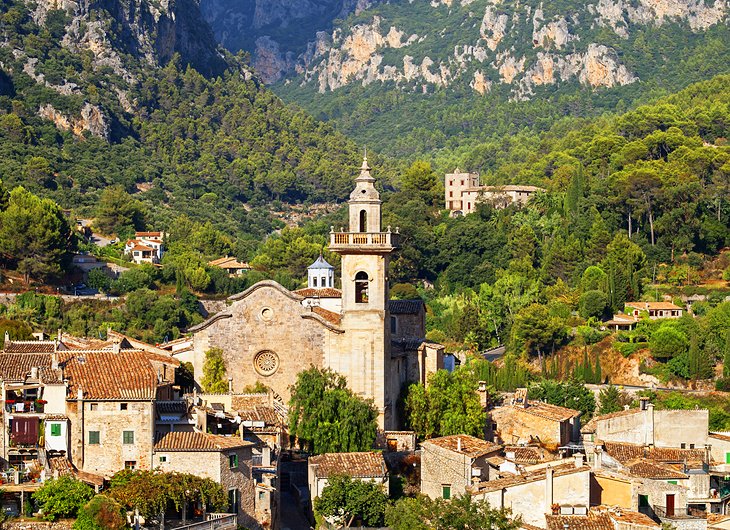
The Hilltop Town and Monastery of Valldemossa
In a picturesque setting between the Tramuntana Mountains and the Mediterranean Sea, the historic village of Valldemossa is filled with charm. Steep pedestrian streets and buildings with old stone facades lend a special ambience. The mountainous area has luxuriant vegetation, and the slopes lead down to beaches and coves. Below the hilltop town is a lovely harbor, the Port of Valldemossa, which still feels like a little fishing village. Tourists will enjoy sampling the fresh seafood specialties at the local restaurants.
The Real Cartuja de Valldemossa, a magnificent Carthusian monastery, was built in the 14th century on the site of an ancient Moorish Alcázar. For more than four hundred years, this serene setting offered spiritual inspiration to the Carthusian Monks who prayed and lived here. Pianist Frédéric Chopin and novelist George Sand spent the winter of 1838-1839 at the monastery, and the room they rented is now open to the public. During the time they lived here, Chopin composed Raindrop Prelude and other works, and George Sand wrote her famous book, A Winter on Majorca.
The expansive grounds of the monastery also include the 14th-century Palacio Rey Sancho built for King Jaime II.
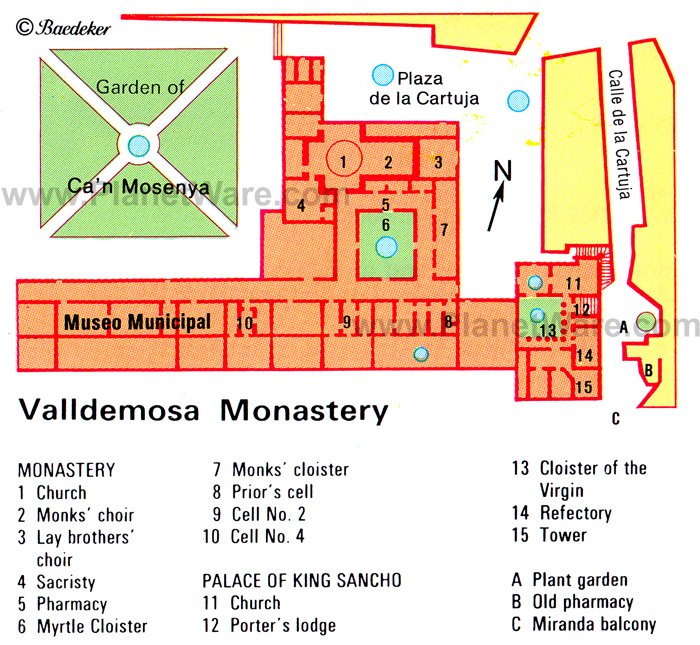
Valldemosa Monastery Map
5. Sóller's Beautiful Seaside Scenery
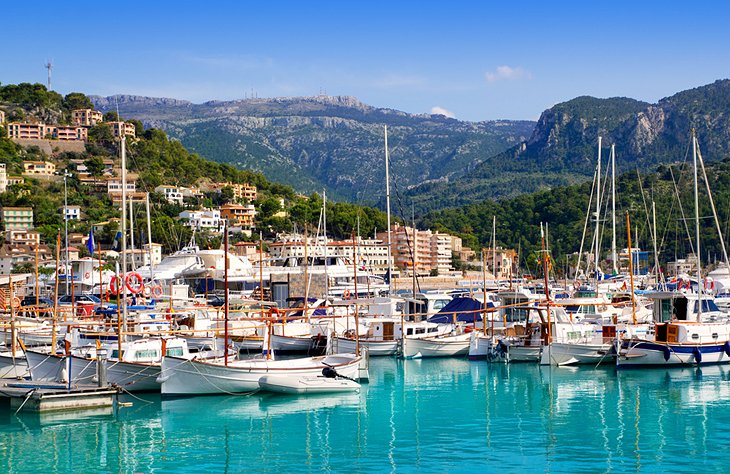
Sóller's Beautiful Seaside Scenery
This lovely little town is tucked away in an idyllic valley, surrounded by beautiful scenery of olive groves and citrus orchards that leads to the sea. The famous Sóller Train takes tourists on a ride through the gorgeous landscape. Visitors can also reach Soller by train from Palma de Mallorca. The ride is enjoyed from a classic Old World railroad car.
The town has several important historic monuments including the 14th-century parish Church of Sant Bartomeu, a monument dedicated to the Sacred Heart of Jesus, and Sa Capelleta Monastery off Lluc road. Outside the town, beyond the Coll de Sóller hillside, is Alfabia Palace, the site of a Moorish Vizier's residence. The property's splendid gardens flourish with fragrant lemon and orange trees, date palms, and bamboo plants.
The palace was designed in Baroque style and contains valuable furniture and paintings. Nestled into the valley, the Port of Sóller has a picturesque marina with the verdant hillsides as a backdrop. Many small boats and yachts are moored in the marina.
6. Llucmajor Beaches
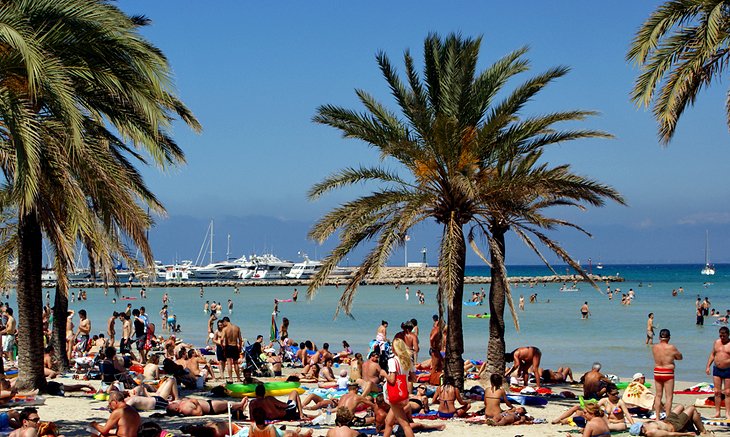
Llucmajor Beaches
For those seeking a sunny beach vacation, Llucmajor is an ideal choice. About 25 kilometres south of Palma de Mallorca, this spectacular stretch of the Mallorca coast has many beautiful coves, beaches, and cliffs. The 16th-century defensive towers along the Llucmajor coast offer stunning views.
The Playa del Arenal is an extensive beach that extends all the way to Palma de Mallorca; the neighboring towns share the same beach. The calm waters of El Arenal Beach are ideal for swimming, while part of the beach is a designated surfing area. Amenities include a yacht club, tourist office, and public toilets. Sun umbrellas, loungers, and watersports equipment are available to rent.
In a protected area at the bottom of a tidal inlet, the Cala Pi Beach has natural charm despite being surrounded by hotels and housing. Cala Pi is a sandy beach with gentle crystal-clear waters that are ideal for scuba-diving. Sunbathers can rent umbrellas and loungers.
Another option is the small cove next to the Cala Blava estate. This beach is very quiet and offers sensational views of Palma Bay. Llucmajor also draws golfers because of its golf course and nautical sports enthusiasts because the area is excellent for sailing.
7. The Port Town of Pollença
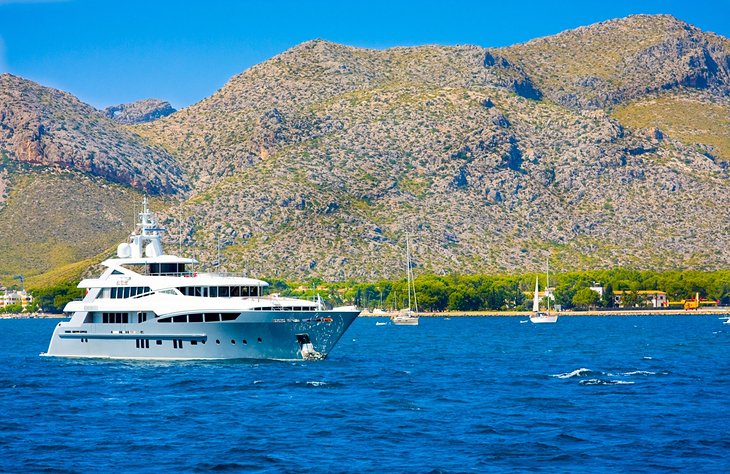
The Port Town of Pollença
Pollença is known for its bustling port and beautiful bay of mesmerizing deep blue seas. In the shadow of the Pollença and Calvari Mountains, the charming medieval town has two important churches. Nuestra Señora de los Angeles (Our Lady of Angels) is the town's 18th-century parish church built on the site of a 13th-century church. From here, a cypress-lined staircase of 365 steps leads up the Iglesia de Puig del Calvari, a Baroque pilgrimage chapel. The historic center of town is only steps away from the beaches.
A popular choice is the Port de Pollença. This gorgeous white-sand beach has an expansive shoreline and moderate waves. The beach has a yacht club, water sports rentals, public toilets, and showers. Sun parasol and lounge chairs are available for rent. Cala en Gossalba is an isolated beach in a remote protected location, accessible by foot or boat. The shore is gravelly rather than sandy. Both Cala en Gossalba are Port de Pollença beaches are ideal for scuba diving.
About six kilometers away from Pollença is the old fishing village of Puerto de Pollença. From here, a beautiful road runs 21 kilometers northeast to Cabo Formentor at the end of a long, narrow peninsula. The luxurious Barceló Formentor Hotel is found on the Cabo Formentor overlooking the sea. At the other side of the bay, after a 15-kilometer drive along the coast, is the Mirador de Mal Pas viewpoint.
8. Artà's Picturesque Historic Town
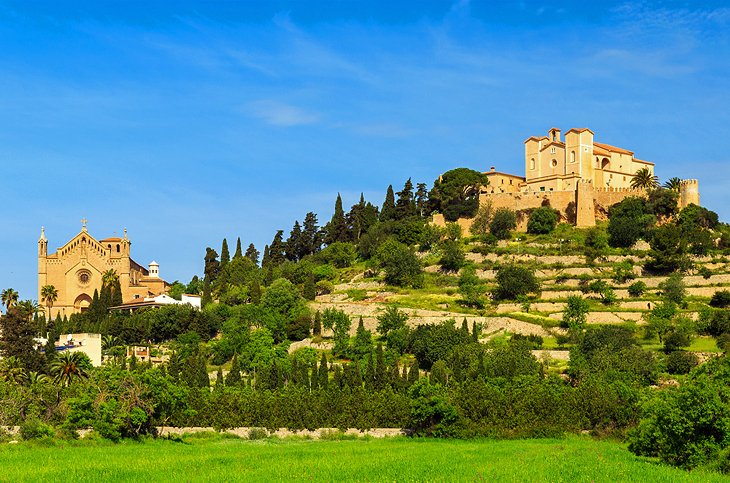
Artà's Picturesque Historic Town
The historic town of Artà is tucked into a valley that flourishes with almond, olive, and fig orchards. The mountains of Artà provide a lovely backdrop with the rolling hills extending into the distance. In fact, Artà derives its name from the Arabic word for "garden" (jertan).
From the town's parish church, the Iglesia de Transfiguración del Señor, a cypress-shaded avenue leads up to the hilltop where a fortress and the Santuari de Sant Salvador (chapel) stand overlooking town. Tourists will enjoy splendid views; the scene overlooks the tightly packed red-tile roofs of the town and extends across the verdant landscape.
Artà still has the remains of its ancient ramparts, which seem to dominate the town, and many palatial old houses, such as Na Batlessa, home to the municipal library. The town also has a Michelin-starred restaurant, Restaurante Andreu Genestra, on the Carretera de Palma a Manacor in a gorgeous setting with views of the countryside from the outdoor terrace.
Outside of Artà is the archaeological site Ses Paísses, the Monasterio de Santa Maria de Bellpuig, the 17th-century Franciscan convent of Sant Antoni de Pádua, and the Ermita de Betlem (hermitage) surrounded by a rugged landscape of scrubland and rocky hills. Another attraction in the area is the Cuevas de Artá sight, a system of caves that contain impressive stalactites and stalagmites.
9. Deia: A Charming Artists' Village
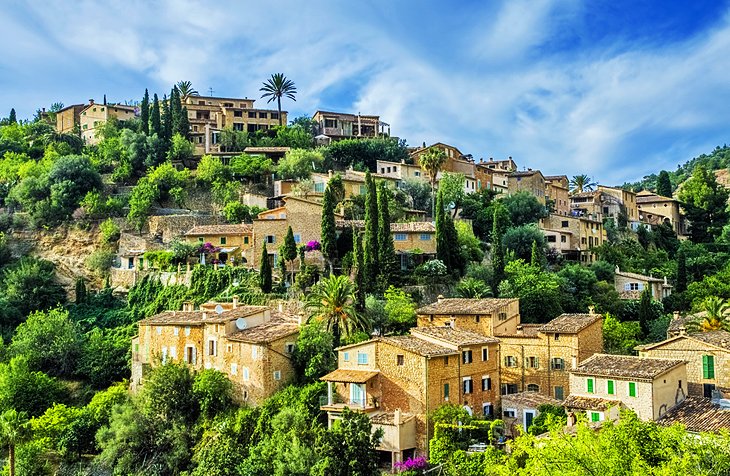
Deia: A Charming Artists' Village
Nestled in the Valle de los Naranjos (Valley of the Oranges), about 15 kilometers from Sóller, this charming artists' village stands on a hillside surrounded by rolling hills and fragrant citrus plantations. The town's quaint stone houses feature tiled roofs and green shutters, typical of rural Mediterranean architecture.
The famous poet Robert Graves appreciated the idyllic setting and lived in the town for many years, inspiring other creative types to follow. The house where Graves lived, Ca N'Alluny, is now a museum open to the public. Deià is a delightful place to explore and soak up the beautiful scenery.
The town is well known for is delicious Balearic cuisine and boasts several top-rated restaurants: the Michelin-starred Es Raco d'es Teix restaurant, the award-winning El Olivo restaurant in the luxurious Hotel La Residencia, and the romantic dining room of Restaurante Sebastian that serves traditional Mallorcan cuisine.
Beyond the historic center of Deia are several worthwhile tourist attractions. The Cala Deia is a small cove with a tiny beach and waters that are perfect for swimming. For sensational views and a serene escape in nature, head outside town to the beautiful Monestir de Miramar and Son Marroig Gardens on the Carretera de Valldemossa. In this idyllic setting, the gardens delight visitors with their lovely landscaping, terraces, pavilions, foot bridges, and pagodas. The Monastery of Miramar also has stunning grounds with balconies overlooking the dramatic cliffs and the deep-blue sea of the coastline.
10. The Quiet Country Town of Petra
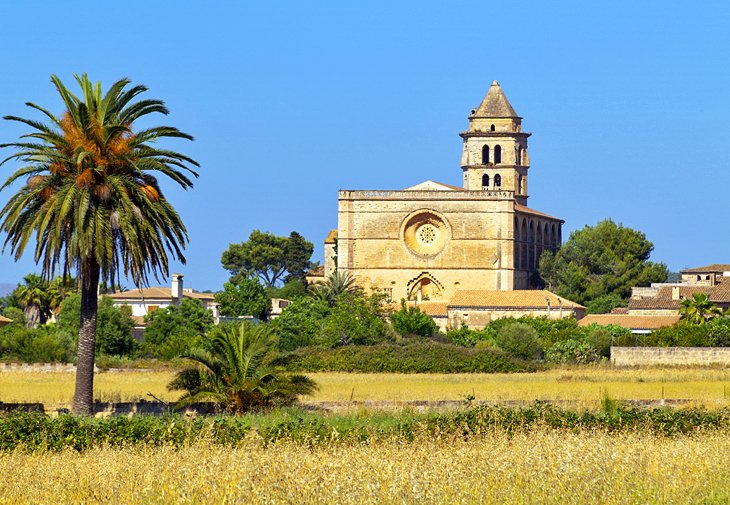
The Quiet Country Town of Petra
Petra is a quiet country town 43 kilometers from Palma de Mallorca and is listed as a Property of Cultural Interest. The most important sight is the convent where Friar Junípero went to school. The town also has an excellent museum that illustrates the life and work of Friar Junípero Serra, who was born in Petra. Another tribute to the famous missionary is the festival held every year on the third Sunday of September. This lively event features parades with impressive floats and colorful floral offerings.
Other interesting monuments in Petra include the Iglesia de San Pedro, a Gothic church with a fortress-like facade; the Convento de Sant Bernardí, a peaceful retreat created for the Franciscans; and the Santuario de Nostra Senyora de Bonany (Sanctuary of Our Lady of Bonany), a Neo-Baroque church that presides over a hilltop.
11. Cala Figuera: A Fishing Port
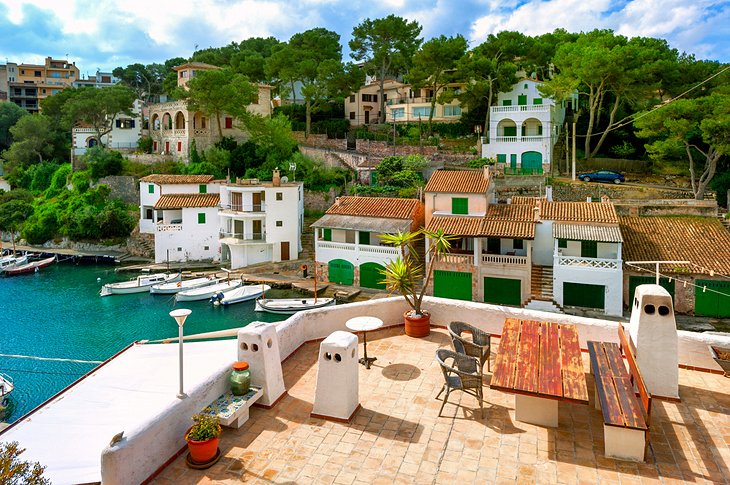
Cala Figuera: A Fishing Port
Along a stunning coastline of serene turquoise waters, the Cala Figuera is a charming fishing village with a laid-back vibe. The town's white-washed houses are clustered around a hillside that reaches the waterfront. Here, many local fishermen take care of their daily task of mending nets. At the earliest hours of the morning, the fresh catches of the day arrive at the docks, ready to be sold at the market and then prepared into delicious seafood dishes.
As expected of a seaside town, Cala Figuera offers a great selection of seafood restaurants that serve fresh local fish. Along the harbor, a scenic walking path follows the water's edge and then leads up into the cliffs. Rewarding views of the bay make the journey worthwhile.
For beach lovers, the popular destination is four kilometers south of Cala Figuera at Cala Santanyi. Well secluded, this pristine sandy beach is prized for its calm, crystal-clear waters. Many visitors enjoy swimming, snorkeling, and scuba diving here.
12. The Calvia Coastline
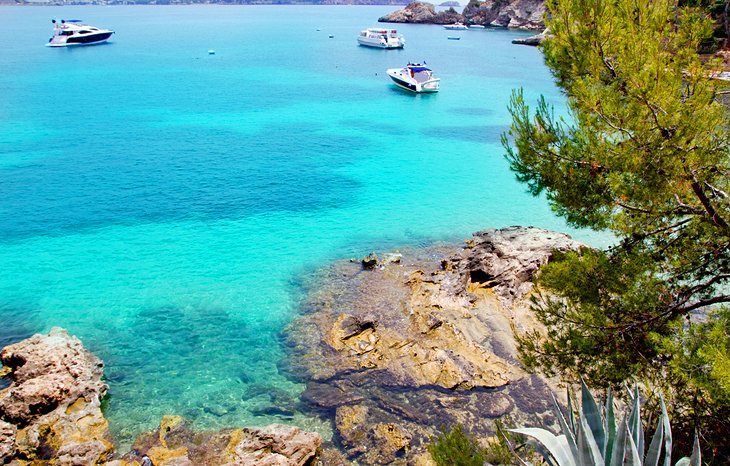
The Calvia Coastline
A spectacular rugged landscape, the Calvià coastline extends 50 kilometers winding around foothills, cliffs, and bays. This area boasts many excellent beaches and remote isles, beckoning sun-worshippers and nature lovers. One of the prettiest beaches is Cala Vinyes, a small sandy shore with calm waters ideal for swimming and bathing. Umbrella and lounge chair rentals are available, however the site has no public toilet facilities.
The Playa de Palma Nova is an award-winning beach with excellent amenities, including public toilets; wheelchair access; showers; and rentals for beach umbrellas, lounge chairs, and other essentials. This is an especially popular beach with families thanks to lifeguards, a dedicated children's area, and calm waters. Plus, with sandy shores extending nearly two kilometers, there's plenty of room to spread out. The beach is also great for water sports and scuba diving.
Other beaches along the Calvia coastline include the Playas Paguera, an urban beach with public facilities, and Cala de Santa Ponsa, an expansive beach with a yacht club, sun umbrella, and lounge chair rentals, and a tourist office.
Comments
Post a Comment